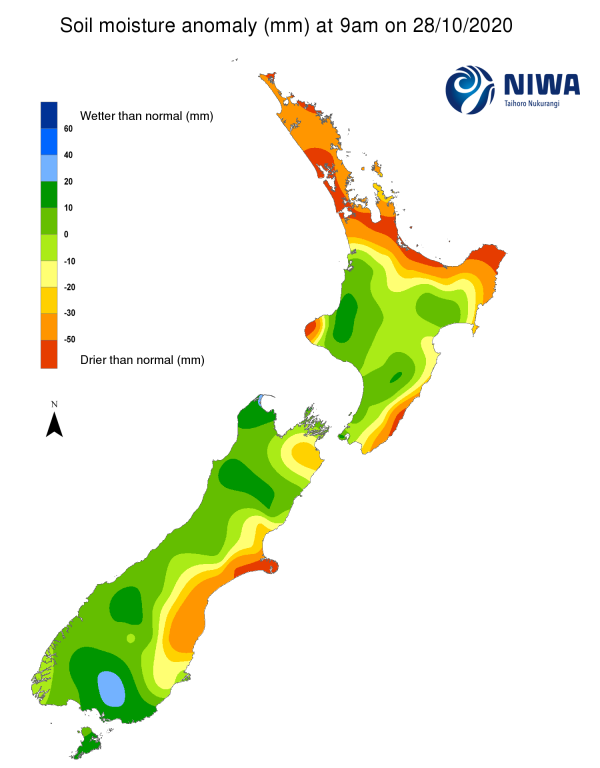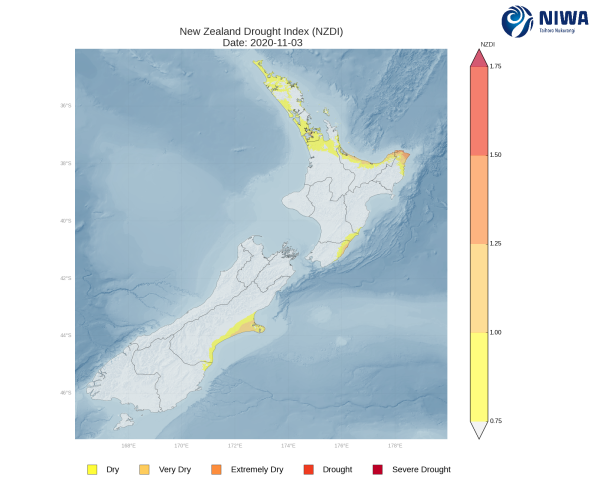A weekly update describing soil moisture patterns across the country to show where dry to extremely dry conditions are occurring or imminent. Regions experiencing significant soil moisture deficits are deemed “hotspots”. Persistent hotspot regions have the potential to develop into drought.
Facts: Soil Moisture
In the North Island, moderate rainfall amounts of generally 25-50 mm occurred across much of Northland and Auckland during the past week, with generally 15-30 mm for much of the western North Island and the western Wellington Region. Conversely, the east coast (including Wairarapa) saw generally light rainfall amounts. Slight soil moisture decreases were again observed in much of the northern third of the North Island and the east coast, while moderate soil moisture increases occurred in western Waikato and much of Manawatu-Whanganui. The driest soils across the North Island, when compared to normal for this time of the year, are found along a tier from Northland through to Auckland, northern Waikato, coastal Bay of Plenty, and northern Gisborne, along with coastal Wairarapa. Meanwhile, the wettest soils for this time of the year are located in western Waikato and eastern Taranaki.
A hotspot remains in place in East Cape, while new hotspots have formed in the past week in a small portion of northwest Auckland and on Aupouri Peninsula.
In the South Island, it was another week with heavy rainfall for the West Coast and Tasman, with widespread accumulations of at least 100-200 mm. Nelson, Tasman and northern Marlborough also received amounts generally in excess of 50 mm. However, the eastern half of the South Island generally saw meagre rainfall amounts of 10 mm or less. This resulted in substantial soil moisture increases across the upper South Island, with minimal changes elsewhere. However, small soil moisture decreases occurred in eastern Otago. The driest soils in the South Island compared to normal for this time of the year are located in Banks Peninsula and coastal Selwyn District, while the wettest soils for this time of the year are found in Nelson, Tasman and surrounding areas as well as interior Southland.
A hotspot continues to run along coastal Canterbury from approximately Christchurch south to northern Otago, although the previous hotspot in eastern Marlborough dissipated this week.
Outlook and Soil Moisture
In the North Island, showers will continue on Friday after heavy rain on Thursday and Thursday night (5 November). A complex area of low pressure will arrive in the region on Sunday and Monday, and this may produce moderate to heavy rainfall for large swaths of the North Island. Thereafter, numerous showers may continue into Tuesday and Wednesday as well (10-11 November). Weekly rainfall totals are likely to be substantial nearly everywhere across the North Island, with 50-100 mm fairly widespread, and isolated areas that may exceed 100 mm.
Due to the substantial rainfall expected in the next week, at least small to moderate soil moisture increases are expected for nearly all of the North Island. This should result in weakening or even disappearance of all current North Island hotspots.
In the South Island, a few showers will be possible on Friday before a front brings rain to the Far South on Saturday. Sunday may be fairly wet in the upper half of the South Island as low pressure arrives, with showery conditions continuing into early next week. Weekly rainfall amounts may reach 40-50 mm in the upper South Island and the West Coast, with generally 15-40 mm in the lower South Island.
Additional small to moderate soil moisture increases may occur in the upper South Island during the next week, while minor increases may also be found in southern areas. This may result in a slight weakening of the hotspot currently located in coastal Canterbury.
Background:
Hotspot Watch: a weekly advisory service for New Zealand media. It provides soil moisture and precipitation measurements around the country to help assess whether extremely dry conditions are imminent.
Soil moisture deficit: the amount of water needed to bring the soil moisture content back to field capacity, which is the maximum amount of water the soil can hold.
Soil moisture anomaly: the difference between the historical normal soil moisture deficit (or surplus) for a given time of year and actual soil moisture deficits.
Definitions: “Extremely” and “severely” dry soils are based on a combination of the current soil moisture status and the difference from normal soil moisture (see soil moisture maps at https://www.niwa.co.nz/climate/nz-drought-monitor/droughtindicatormaps)
Hotspot: A hotspot is declared if soils are "severely drier than normal" which occurs when Soil Moisture Deficit (SMD) is less than -110 mm AND the Soil Moisture Anomaly is less than -20 mm.
Pictured above: Soil Moisture Anomaly Maps, relative to this time of year. The maps show soil moisture anomaly for the past two weeks.
New Zealand Drought Index (NZDI)
As of 3 November, the New Zealand Drought Index (NZDI) map below shows that very dry or extremely dry soils are now located in coastal Bay of Plenty, East Cape, Wairarapa, and coastal Canterbury, but meteorological drought is not currently found in New Zealand. Please note: some hotspots in the text above may not correspond with the NZDI map. This difference exists because the NZDI uses additional dryness indices, including one which integrates the rainfall deficit over the past 60 days. Changes are therefore slower to appear in the NZDI compared to soil moisture anomaly maps that are instantaneously updated.




